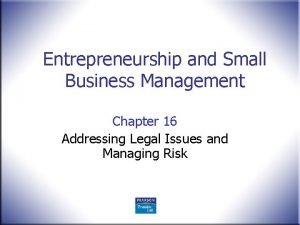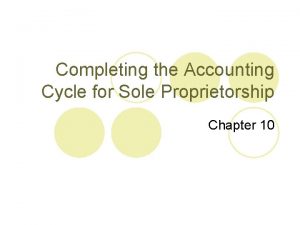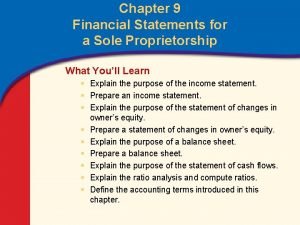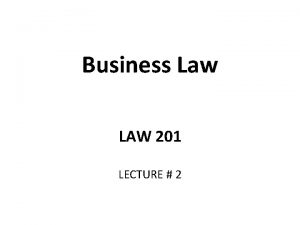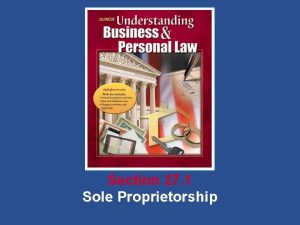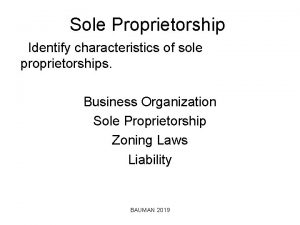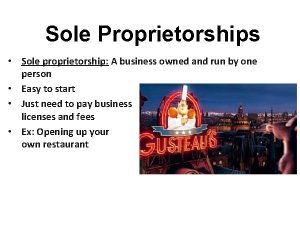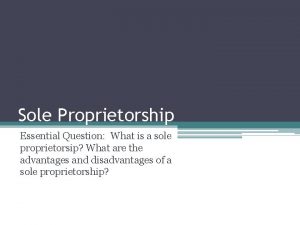Sole Proprietorship v As the name indicates Sole













- Slides: 13

Sole Proprietorship v As the name indicates, Sole Proprietorship is owned and operated by one individual. v The Sole Proprietor, however, may hire any number of employees to act on behalf of the sole proprietorship. Advantages of Sole Proprietorship v v v Full Management Authority Minimal Formalities Ease of formation Low cost of organization No double taxation Ease of business termination

Sole Proprietorship Disadvantages of Sole Proprietorship v v v Unlimited Liabilities Lack of business Continuity No diversity in management Limited ability to attract high caliber employees Restrict ability to raise capital

Partnership • A partnership is an “association of two or more persons who have agreed to share the profits of a business carried on by all or any of them acting for all. ” • Essential elements of partnership are 1. Two or more Persons: There must be at least two persons to form a partnership and all such persons must be competent to contract. Every person except the following is competent A. Minor B. Persons of unsound mind (e. g. lunatics, idiots) C. Persons disqualified by any law to which they are subject (e. g. insolvents). 2. Agreement: There must be an agreement to form a partnership. This agreement may be expressed (written or oral) or implied. 3. Business: There must exist a business. According to Section 2(b), the term business includes every trade, occupation and profession.

Partnership 4. Sharing of Profits: There must be sharing of profits. However, sharing of profits is a prima facie evidence and not a conclusive evidence of partnership. 5. Mutual agency: ‘Mutual Agency’ relationship means that each partner is both an agent and a principal. Each partner is an agent in the sense that he has the capacity to bind other partners by his acts done. Each partner is an principal in the sense that he is bound by the act of other partners. Ø The true test of partnership is not the sharing of profits by the existence of mutual agency relationship. Ø Eg: A widow or child of a deceased partner who receives a share of profits. (Do not have mutual agency relation)

Partnership • Registration is not compulsory for partnership. However, if the firm is not registered, it will be deprived of certain legal benefits. • The effect of non registration are Ø Firm cannot take any action in a court of law against any other parties for settlement of claims. Ø If there is any dispute among partners, it is not possible to settle the dispute through a court of law. • The partner should always carry on any kind of lawful business. • In the absence of any “agreement” for profit sharing, it should be shared “equally” among the partners. • No partner can sell or transfer his share or partnership of the firm to any one without the consent of the other partners • A partnership firm comes to an end at death, lunacy or bankruptcy of any partner

Partnership deed q A partnership formed by an agreement. This agreement may be express (i. e. oral or in writing) or implied. q The partnership deed contains various provisions relating to various matters such as ü The amount of initial capital contributed by each partner ü Profit or loss sharing ratio for each partner ü Salary or commission payable to the partners, if any ü Duration of business, if any ü Name and address of the partners and the firm ü Duties and powers of each partner; ü Nature and place of business; and ü Any other terms and conditions to run the business ü Method of valuation of goodwill.

Partnership Advantages of Partnership ü ü ü All partners are entitled to manage the partnership. Maximum flexibility in management. Minimal formalities and regulatory and reporting requirements. Low cost of organization. No double taxation. Disadvantages of Partnership ü Under most circumstances partners may be held personally responsible for the debts and obligations of the partnership. ü Lack of business continuity. ü Difficulty in transferring interest in partnership. ü Limited ability to raise the capital. ü Partnership taxation may not be beneficial for all partners under all circumstances.

Types of Partnership Limited Partnership A partnership formed by general partners (who run the business and have liability for all partnership debts) and limited partners (who partly or fully finance the business, take no part in running it, and have no liability for partnership debts beyond the money they put in or promise to put in) General Partner 1. Synonymous with partner. A partner in a general partnership, or limited partnership, who typically has unlimited personal liability for the debts and liabilities of the partnership. 2. A member of a general or limited partnership who shares in the profits and losses of the partnership and may participate fully in the management of the partnership. General partners are usually personally liable for the debts and obligations of the partnership. Limited Partner A partner who invests in a limited partnership, but does not assume personal liability for the debts and obligations of the partnership. Limited partners may not participate in the management of the limited partnership in most states.

General Partnership. V/S Limited partnership General Partnership All partners are general partners. Limited Partnership The limited partnership must have at least one general partner and may have any number of limited partners. All partners are personally liable for The general partners are personally responsible for the debts and obligations of the limited partnership. Limited partners risk only their investment in the limited partnership. Unless otherwise provided in the partnership agreement, all partners have an equal right to manage the partnership business. In most states limited partners may not participate in the control and management of the limited partnership or they will lose their limited liability status. A general partnership may be formed State law provide for the formation of limited without filing any documentation at partnerships. A limited partnership certificate must the state level. be filed at the state level before the entity exists.

Types of Partner v Active Partner: The partners who actively participate in the day-today operations of the business are known as ‘Active’ or ‘Ostensible partners’. v Dormant or Sleeping Partner: Those partners who merely put in their capital and do not participate in the day-to-day activities. They only contribute capital and share the profits or bear the losses, if any. v Partners in Profits only: Partner will be entitled to a certain share of profits, without being liable for the losses. Such a partner has no voice in the management of the business. However, his liability vis-à-vis third parties will be unlimited. v Sub partner: When a partner agrees to share his profits in a partnership firm with an outsider, such an outsider is called a subpartner. Such a sub-partner has no rights against the firm nor he is liable for the debts of the firm.

Types of Partner v Nominal Partner: These partners “only” allow the firm to use their “name” as a partner. They “do not” have any real interest in the business of the firm. They do not invest any capital, or share profits and also do not take part in the business of the firm. However, they do remain liable to third parties for the acts of the firm. v Minor Partner: In special cases a minor can be admitted as partner with certain conditions. A minor can only share the profit of the business. In case of loss his liability is limited to the extent of his capital contribution for the business.

Company VS Partnership S. no Criteria Company Partnership 1 Formation A company is incorporated by registration under the Companies Act, 1956. A partnership is established by agreement which may be expressed or implied from the conduct of the partners. 2 Status at Law A company is considered to be an artificial legal person with perpetual succession A partnership is not a separate legal entity, though it may sue and be sued in the firm’s name. 3 Authority of members No ‘Mutual Agency’ relation between shareholders Must have a ‘Mutual agency’ relation 4 No of Members Private Company: 2 to 200 Public Company : 7 to Unlimited 2 to 20 10 (banking business) 5 Management Members are not entitled to take part, unless they become directors Entitled to take part in management activities 6 Liability Unlimited Limited by shares, or guarantee. 7 Termination No member can wind up Any member at any time, if it is ‘at will’, can wound up without legal formalities

Company VS Partnership S. no Criteria Company Partnership 8 Registration Essential Voluntary 9 Audit Legal necessity Only if the annual total sales, turnover or gross receipts in business exceed Rs 40 lakh. 10 Transfer of Interest Private Co. : With approval of Board of directors Public Co. : Power transfer with the shares Cannot transfer his interest without the consent of all partners. 11 Transfer of Shares Private Co. : With approval of Board of directors Public Co. : Freely transferable Can transfer, but the assignee does not become a partner
 Disadvantages of multinational corporation
Disadvantages of multinational corporation Venn diagram of sole proprietorship and partnership
Venn diagram of sole proprietorship and partnership Advantages and disadvantages of a sole proprietorship
Advantages and disadvantages of a sole proprietorship Jollibee sole proprietorship
Jollibee sole proprietorship Advantages of sole trader
Advantages of sole trader Example of proprietorship
Example of proprietorship Partnership advantages and disadvantages
Partnership advantages and disadvantages Sole proprietorship pros and cons
Sole proprietorship pros and cons Post-closing trial balance for a sole proprietorship
Post-closing trial balance for a sole proprietorship Financial statement of sole proprietorship
Financial statement of sole proprietorship Sole proprietorship
Sole proprietorship Forms of business organization venn diagram
Forms of business organization venn diagram Is microsoft a sole proprietorship
Is microsoft a sole proprietorship X-201 for a sole proprietorship
X-201 for a sole proprietorship







